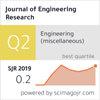基于 CFD-DPM 方法的室内消毒喷雾分布数值模拟研究
IF 0.9
4区 工程技术
Q3 ENGINEERING, MULTIDISCIPLINARY
引用次数: 0
摘要
当今世界,环境安全已成为重中之重,尤其是室内环境的终端消毒,这已被证明是感染控制中一个至关重要的棘手问题。传统的擦拭消毒和紫外线消毒方法存在消毒不彻底等问题,而过氧化氢汽化或雾化消毒方法可以显著降低室内的病毒含量,因此,使用过氧化氢消毒是解决这些问题的可行办法。为了改进过氧化氢消毒喷雾的应用,本研究采用了 CFD-DPM(计算流体力学-离散粒子模型)方法来模拟传统喷雾在 30 立方米房间内的粒子分布。研究重点是分析消毒喷雾的放置位置和瓶数对喷雾颗粒分布的影响。结果表明,数值模拟方法和实验结果在不同方案的消毒喷雾粒径分布方面具有惊人的一致性,验证了该方法的准确性和可靠性。然而,当特定房间内有卫生间时,单个消毒喷雾源的布置不足以实现颗粒在整个空间的均匀分布。不过,通过在浴室内放置内部和外部消毒喷雾源,消毒喷雾颗粒的分布会变得更加均匀,这要归功于精心构思的放置技术和喷雾源数量的增加。在所有测试方案中,方案 4 能够产生最多的喷雾颗粒,其中近 60.71% 的颗粒在空气中停留时间超过 40 秒。本文章由计算机程序翻译,如有差异,请以英文原文为准。
Numerical simulation study of indoor disinfection spray distribution based on CFD-DPM method
In today's world, environmental safety has become a top priority, with a special focus on terminal disinfection of indoor environments, which has proven to be a crucial and formidable issue in infection control. The use of hydrogen peroxide disinfection through vaporization or atomization presents a viable solution to the challenges posed by traditional wiping disinfection and ultraviolet disinfection methods that are plagued by incomplete disinfection and other factors that can significantly reduce the virus content within a room. To improve the application of hydrogen peroxide disinfection spray, the CFD-DPM (Computational Fluid Dynamics-Discrete Particle Model) method is employed to simulate the particle distribution of traditional sprays in a 30 m3 room. The study places emphasis on analyzing the impact of the placement position and bottle number of disinfection spray on the distribution of spray particles. The results demonstrate an impressive consistency between the numerical simulation method and experimental findings regarding the particle size distribution of disinfectant spray across various Schemes, validating the method's accuracy and reliability. However, the placement of a single disinfection spray source is insufficient to achieve uniformly distributed particles throughout the space when a bathroom is present within a given room. Nevertheless, by placing internal and external sources within the bathroom, the distribution of disinfectant spray particles becomes more even, thanks to a well conceived placement technique and an increased number of spray sources. Among all the schemes tested, Scheme 4 stands out for its ability to produce the greatest number of spray particles, with almost 60.71% of these particles remaining airborne for over 40 s. Therefore, it is also the most effective scheme for conducting disinfection.
求助全文
通过发布文献求助,成功后即可免费获取论文全文。
去求助
来源期刊

Journal of Engineering Research
ENGINEERING, MULTIDISCIPLINARY-
CiteScore
1.60
自引率
10.00%
发文量
181
审稿时长
20 weeks
期刊介绍:
Journal of Engineering Research (JER) is a international, peer reviewed journal which publishes full length original research papers, reviews, case studies related to all areas of Engineering such as: Civil, Mechanical, Industrial, Electrical, Computer, Chemical, Petroleum, Aerospace, Architectural, Biomedical, Coastal, Environmental, Marine & Ocean, Metallurgical & Materials, software, Surveying, Systems and Manufacturing Engineering. In particular, JER focuses on innovative approaches and methods that contribute to solving the environmental and manufacturing problems, which exist primarily in the Arabian Gulf region and the Middle East countries. Kuwait University used to publish the Journal "Kuwait Journal of Science and Engineering" (ISSN: 1024-8684), which included Science and Engineering articles since 1974. In 2011 the decision was taken to split KJSE into two independent Journals - "Journal of Engineering Research "(JER) and "Kuwait Journal of Science" (KJS).
 求助内容:
求助内容: 应助结果提醒方式:
应助结果提醒方式:


